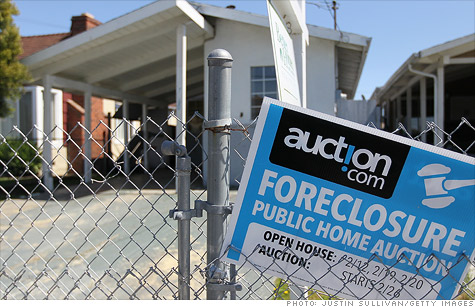Search News

After several years of pain, the latest statistics from the Mortgage Bankers Association point to a housing market on the mend.
NEW YORK (CNNMoney) -- The mortgage delinquency picture is getting brighter, according to an industry report released Thursday, with falling delinquency rates indicating the housing crisis may be at the beginning of its end.
A quarterly release from the Mortgage Bankers Association revealed that mortgage payment problems eased during the first three months of 2011 for every category of default.
The rate of loans past due, unadjusted for seasonal factors, decreased 1.17 percentage points to 7.79% from 8.96% during the last quarter of 2010. It was down 1.59 points year-over-year..
"These numbers point to a mortgage market on the mend," said Jay Brinkmann, MBA's chief economist. "Foreclosure starts are at the lowest level since the end of 2008 and had the second largest drop ever. The percentage of loans somewhere in foreclosure is down from last quarter's record high and also had one of the largest drops we have ever seen."
He noted the improved performance of loans issued during the years 2005 through 2007, many of which were of the toxic, subprime variety. Those were the mortgages that, he said, "drove the market collapse." They still accounted for 65% of all delinquencies last quarter, even though they represent just 31% of loans outstanding.
Those loans are performing better now, mostly because many of the worst loans have already been purged from the system through foreclosure, and the remaining ones are now past the age when mortgages usually default.
That, combined with the much stricter underwriting standards for newer mortgages, has improved overall credit quality, and delinquencies should continue to drop.
Even in their improved numbers, the delinquency statistics may be overstating the problem, according to Brinkmann.
He said massive problems in local markets may dominate national data, obscuring the positive trends happening elsewhere. Florida, for example, accounted for nearly a quarter of all homes in foreclosure during the quarter and 23% of loans there are in some stage of delinquency.
"The state has more homes in foreclosure than 22 states have loans," said Brinkmann. "That's why I don't put too much stock in the national numbers. The problem states have too much impact on them."
The overall national decline comes despite continuing delays in processing foreclosures stemming from the "robo-signing" scandal in which banks were accused of mishandling legal paperwork.
As a result, foreclosures take longer to work through the system, so they show up in delinquency rates quarter after quarter. In New York, for example, the average length of time between a first missed payment and the final bank repossession is now more than two years.
In Florida, according to Brinkmann, many attorneys no longer handle foreclosure cases; the banks are having trouble finding attorneys to foreclose. If they can work through this problem, delinquency rates could decline faster.
Meanwhile, the nation's continued, albeit slow-motion, economic recovery is also providing some relief. There's a close correlation between unemployment and mortgage payment problems. Not only are people with jobs more able to make their mortgage payments than unemployed borrowers, but hiring itself boosts consumer confidence and, ultimately, housing markets.
"People with jobs feel they're less likely to lose them [when they see other people being hired]," said Brinkmann.
That makes them more likely to form new households and buy homes. Some of those homes they buy are in foreclosure, which clears those properties out of delinquency reports such as this one.
The light at the end of the foreclosure crisis tunnel may still be some distance off, but at least it's visible again after years of doom and gloom. ![]()
| Overnight Avg Rate | Latest | Change | Last Week |
|---|---|---|---|
| 30 yr fixed | 3.80% | 3.88% | |
| 15 yr fixed | 3.20% | 3.23% | |
| 5/1 ARM | 3.84% | 3.88% | |
| 30 yr refi | 3.82% | 3.93% | |
| 15 yr refi | 3.20% | 3.23% |
Today's featured rates: